Tennessee is home to over 30 species of snakes, including four that are venomous. Here are snakes you may encounter in the state and what to know about their bites.
VENOMOUS SNAKES IN TENNESSEE
Of the venomous snakes found in the United States, rattlesnakes, copperheads and cottonmouths (“water moccasins”) can be found in Tennessee. The venomous coral snake is not found in Tennessee, but its nonvenomous lookalike, the scarlet snake, does reside across most of the state.
All four of the venomous snakes in Tennessee are pit vipers, each of which have two movable fangs and a heat-sensitive pit organ between each eye and nostril that help them accurately aim their strikes at warm-blooded prey.
A venomous bite is called an “envenomation.” Although death from venomous snake bites is rare, a person with a severe envenomation or allergy to snake venom can die from a venomous bite. Each year, about 7,000–8,000 people are bitten by venomous snakes in the United States, and about five of those people die. The number of deaths would be much higher if people did not seek medical care, according to the Tennessee Wildlife Resources Agency.
It’s illegal to kill a snake in Tennessee unless there is an immediate threat or danger to people, pets or livestock, according to TWRA spokeswoman Mime Barnes.
1. Copperhead
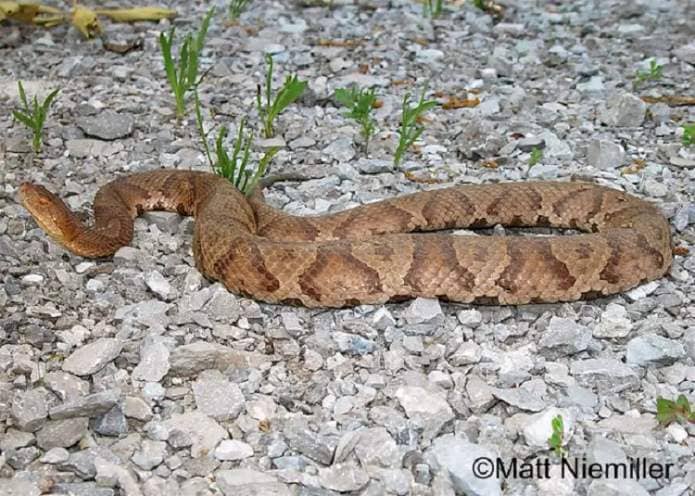
Subspecies: Southern copperhead (in extreme West Tennessee) and northern copperhead (found across the rest of the state).
Description: Medium-sized, heavy-bodied snake (24-36 inches in length) with a large, triangular-shaped coppery-red head and vertical pupils. Distinctive dark brown “hourglass” crossbands are wide on sides and narrow at the center of the back. Body color is variable, but is usually light brown or gray.
Belly is usually gray to pink with darker blotches. Facial pits occur on each side of head between the eye and nostril and a little below. Scales are keeled. Southern copperheads are paler and pinker than the northern subspecies. Males are larger than females. Young resemble adults but have bright yellow tails.
 A copperhead snake, one of the four types of venomous snakes in Tennessee. / Photo courtesy of the Tennessee Wildlife Resources Agency
A copperhead snake, one of the four types of venomous snakes in Tennessee. / Photo courtesy of the Tennessee Wildlife Resources AgencyHabitat: Generally prefers forested habitat. Often found on rocky, wooded hillsides with abundant logs, leaf litter or rocks for cover. Can also be found in urban and suburban environments, as well as near wetland and stream edges. Found across all of Tennessee.
Diet: Mainly mice, but also small birds, lizards, snakes, amphibians and insects (especially cicadas).
Fun facts: Copperhead venom is not very potent, so fatalities from bites are rare.
Juvenile copperheads wiggle the bright yellow tip of their tail to lure prey within striking distance, a behavior known as caudal luring.
2. Cottonmouth (“water moccasin”)
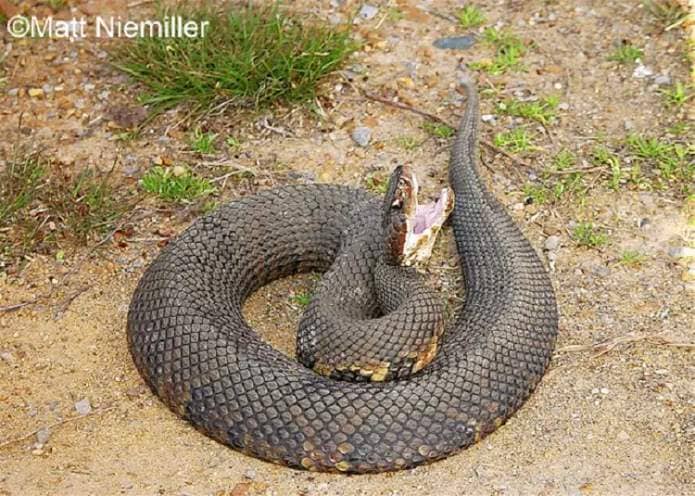 A cottonmouth snake (also known as a “water moccasin”), one of the four types of venomous snakes in Tennessee. / Photo courtesy of the Tennessee Wildlife Resources Agency
A cottonmouth snake (also known as a “water moccasin”), one of the four types of venomous snakes in Tennessee. / Photo courtesy of the Tennessee Wildlife Resources AgencySubspecies: Western cottonmouth.
Description: Large and heavy-bodied (30-42 inches in length) with keeled scales, vertical pupils and a triangular head. Western cottonmouths are dark olive-brown to almost black with dark crossbands that may not be visible. The top of the head is dark brown or black, and a dark, wide band may be visible from the snout through the eye and onto the neck.
A white upper lip may be noticeable. There is a large sensory pit on each side of the head between the nostril and eye. Belly is tan or gray with dark blotches. Males are longer and heavier than females. Young are lighter with distinct crossbands and a yellow-tipped tail.
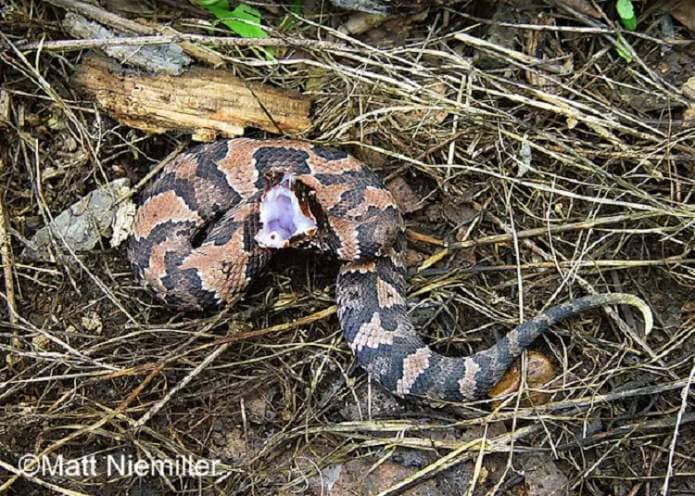 A cottonmouth snake (also known as a “water moccasin”), one of the four types of venomous snakes in Tennessee. / Photo courtesy of the Tennessee Wildlife Resources Agency
A cottonmouth snake (also known as a “water moccasin”), one of the four types of venomous snakes in Tennessee. / Photo courtesy of the Tennessee Wildlife Resources AgencyHabitat: Mainly found in swamps, sloughs, wetlands and drainage ditches of the Western Tennessee coastal plain. Occasionally found around rivers and lakes. Can be found swimming in the water, coiled on the bank or in vegetation along the shore. Found in the western third of Tennessee, including counties on the northern Highland Rim.
Diet: Mostly eats fish, frogs, salamanders, lizards, birds, rodents and other snakes.
Fun facts: Cottonmouths got their name from their behavior of opening their mouths in a defensive posture to show white, puffy lining.
The aggressive nature projected onto cottonmouths is greatly exaggerated. These snakes generally try to escape if encountered and escape in a random direction, thus occasionally coming at a person rather than away.
3. Timber Rattlesnake
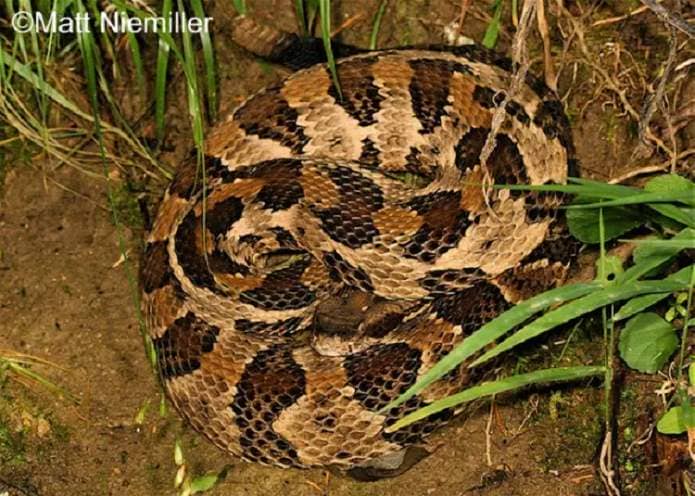 A timber rattlesnake, the largest and most dangerous of the four types of venomous snakes in Tennessee. / Photo courtesy of the Tennessee Wildlife Resources Agency
A timber rattlesnake, the largest and most dangerous of the four types of venomous snakes in Tennessee. / Photo courtesy of the Tennessee Wildlife Resources AgencyDescription: Large, heavy-bodied snake (36-60 inches in length) with a large, triangular head, vertical pupils and the characteristic rattle at the end of the tail. Body coloration is highly variable but is usually gray with a black tail. Other colors may include yellow, tan, brown, pink, dark brown or black. Black chevron-shaped crossbands occur all down the body. Typically, a rust-colored stripe occurs down the center of the back.
The top of the head is gray, light tan or yellow with a dark brown line extending from each eye to the angle of the jaw. Scales are keeled. There is a large sensory pit on each side of the head between the nostril and eye. The belly is tan or light gray sprinkled with brown specks. Males are larger than females. Young are lighter in color than adults.
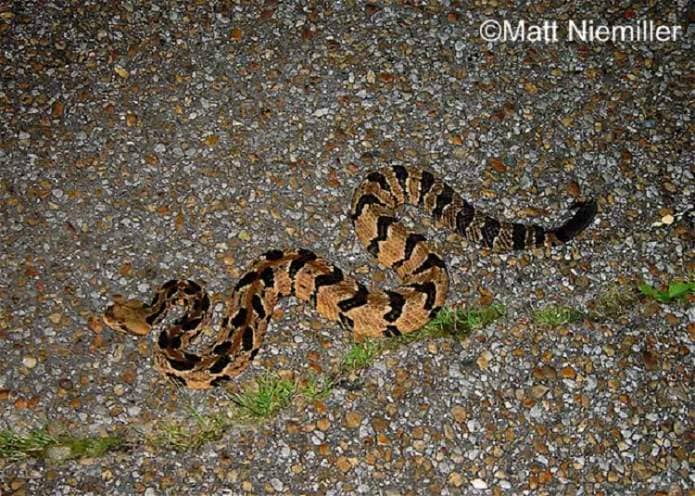 A timber rattlesnake, the largest and most dangerous of the four types of venomous snakes in Tennessee. / Photo courtesy of the Tennessee Wildlife Resources Agency
A timber rattlesnake, the largest and most dangerous of the four types of venomous snakes in Tennessee. / Photo courtesy of the Tennessee Wildlife Resources AgencyHabitat: Prefers mature, heavily wooded forests with rocky, south-facing hillsides. Often associated with bluffs or ledges. They can also be found around mountains, swamps, cane thickets, wooded stream corridors and rural areas. Timber rattlesnakes are commonly seen coiled near fallen logs or sunning on rocks. Found across all of Tennessee.
Diet: Mostly small rodents such as mice, rats, chipmunks and squirrels. Occasionally eats birds, lizards and other small mammals.
Fun facts: The timber rattlesnake is the largest and the most dangerous of the venomous snakes in Tennessee.
The rattle, which is used to warn predators, is tan or gray in color and consists of hollow, interlocking segments made of keratin. Newborn rattlesnakes have a single segment on its rattle, called a “button.” Each time the snake sheds, a new segment is added to the base of the rattle.
4. Pygmy Rattlesnake
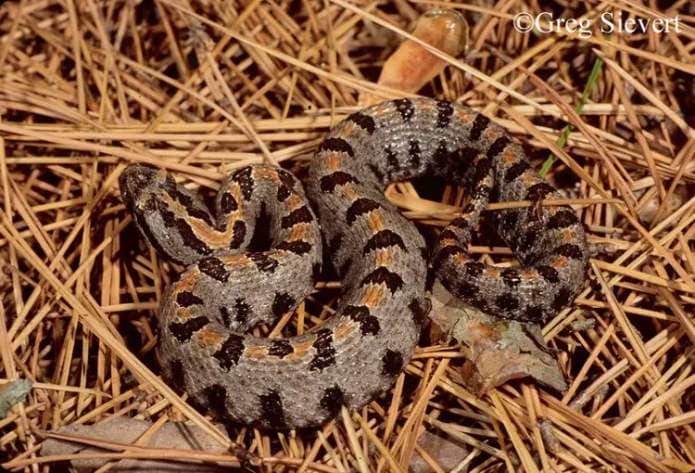 A pygmy rattlesnake, one of the four types of venomous snakes in Tennessee. / Photo courtesy of the Tennessee Wildlife Resources Agency
A pygmy rattlesnake, one of the four types of venomous snakes in Tennessee. / Photo courtesy of the Tennessee Wildlife Resources AgencySubspecies: Western pygmy rattlesnake (found along the western Highland Rim from Stewart County to the southern border).
Description: A small, colorful rattlesnake (15-20 inches in length) with vertical pupils, thin tail and tiny rattle. The body color is gray or tan with an orangish-brown mid-dorsal stripe usually present. There are dark blotches, typically bar-shaped, running along the length of the back, with one or two rows of dark spots along each side of the body.
The head has a wide, black stripe, which starts at the eye and slopes down to the corner of the mouth. The crown of the head also has nine large plates. Belly is dusky cream-color mottled with dark bars. Scales are keeled. Young have yellow-tipped tails.
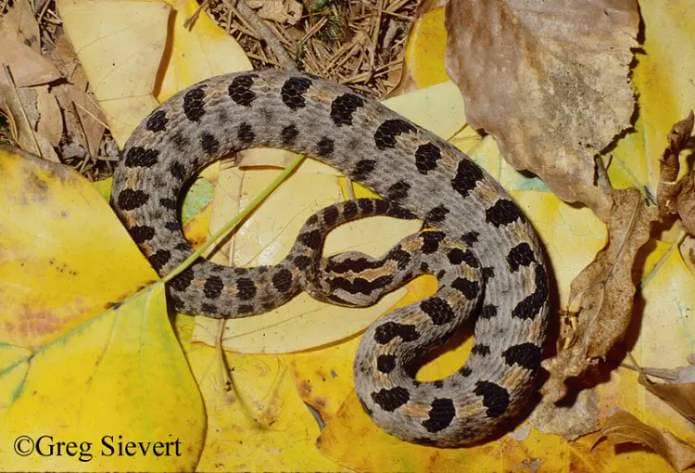 A pygmy rattlesnake, one of the four types of venomous snakes in Tennessee. / Photo courtesy of the Tennessee Wildlife Resources Agency
A pygmy rattlesnake, one of the four types of venomous snakes in Tennessee. / Photo courtesy of the Tennessee Wildlife Resources AgencyHabitat: Various, but usually in close proximity to water. Most commonly found in flood plains, wetlands and moist fields. Occasionally found in rocky uplands, pine woods and glades.
Diet: Prefers frogs, lizards, small snakes, amphibians and small rodents.
Fun facts: The pygmy rattlesnake is the smallest venomous snake in Tennessee.
Its tiny rattle sounds like the faint buzz of an insect and can usually be heard no farther than 3 feet away.
Pygmy rattlesnakes are good swimmers.
(READ MORE: Lookout Mountain woman bitten by rattlesnake shares advice to avoid snake bites)
SYMPTOMS OF A SNAKE BITE
— Puncture marks at the wound
— Redness, swelling, bruising, bleeding or blistering around the bite
— Severe pain and tenderness at the site of the bite
— Nausea
— Vomiting
— Diarrhea
— Labored breathing (in extreme cases, breathing may stop altogether)
— Rapid heart rate
— Weak pulse
— Low blood pressure
— Disturbed vision
— Metallic, mint or rubber taste in the mouth
— Increased salivation and sweating
— Numbness or tingling around face and/or limbs
— Muscle twitching
WHAT TO DO IF YOU GET BITTEN
— Stay calm. While painful, snake bites can be treated and are rarely fatal.
— Keep the arm or leg (usual sites for a snake bite) immobile, in a neutral position and below the level of the heart. This can slow down the spread of venom if the snake is venomous.
— Remove any jewelry and constricting clothing from the area of the bite.
— Take a photograph of the snake from a safe distance, if possible. Identifying the snake can help with treatment of the bite. If you can’t take a photo, try to see and remember the color and shape of the snake.
— Seek medical attention as soon as possible (dial 911 or call your local emergency medical services).
— Wash the bite gently with soap and water if this won’t delay transport to the hospital. Cover the bite with a clean, dry dressing.
— Mark the leading edge of tenderness/swelling on the skin and write the time alongside it.
— Call Poison Control (1-800-222-1222) right away. The poison specialists and medical/clinical toxicologists on staff are experts in treating snake bites and will work with the physicians in the emergency department so you’ll get the proper treatment. Although there are a variety of folklore practices and commercial products for treating snake bites, evidence shows there is nothing that can be done in the field to significantly alter the outcome of a snakebite.
WHAT NOT TO DO IF YOU GET BITTEN
— Don’t risk another bite by trying to capture or kill the snake. Never handle a venomous snake, not even a dead one or its decapitated head. A dead snake or decapitated head can still envenomate a person.
— Don’t wait for symptoms to appear before getting medical help.
— Don’t apply a tourniquet. These can lead to ischemia, gangrene and amputation.
— Don’t cut the wound in any way or suck out the venom (either by mouth or with an extractor device). Experimental models show these do not extract any venom and increase local tissue damage. Additionally, oral suction can introduce bacteria into the wound and cause an infection.
— Don’t apply ice or immerse the wound in water. This will not slow the spread of venom and can cause significant frostbite.
— Don’t attempt to shock the wound with a stun gun or other electrical current. While there are numerous personal testimonials and anecdotal reports (including a few that involve a car and a set of jumper cables), experimental models show no benefit and delayed wound healing.
— Don’t drive yourself to the hospital. People with snake bites can become dizzy or pass out.
— Don’t take pain relievers such as aspirin, ibuprofen or naproxen.
— Don’t drink alcohol as a painkiller.
— Don’t drink caffeinated beverages.
NON-VENOMOUS SNAKES THAT CAN BE FOUND IN THE CHATTANOOGA AREA
— Eastern worm snake
 Worm snake / Photo courtesy of the Tennessee Wildlife Resources Agency
Worm snake / Photo courtesy of the Tennessee Wildlife Resources AgencySubspecies: Eastern worm snake (in the Great Valley and Unaka Mountains of east Tennessee) and the midwestern worm snake (across the rest of the state)
Description: A small, shiny, smooth-scaled snake (7.5-11 inches in length) with a sharp contrast between brown back and pink belly. Often has an iridescent sheen. Head is small and pointed with tiny eyes. Tail is short and pointed. Young are darker and smaller. The eastern wormsnake has separate prefrontal and intranasal scales (scales between nose and eyes), while the midwestern wormsnake’s are fused.
 Worm snake / Photo courtesy of the Tennessee Wildlife Resources Agency
Worm snake / Photo courtesy of the Tennessee Wildlife Resources AgencyHabitat: Under rocks, rotten logs, leaf litter and other debris of hardwood forests, usually moist. Prefers to remain underground or under cover.
Diet: Mainly earthworms, but may also eat grubs, insect larvae and other soft-bodied prey.
Fun facts: The worm snake is one of the most fossorial (living underground) snakes in the state.
Their small, pointed heads are ideal for burrowing in cracks and crevices.
— Scarlet snake
 Scarlet snake / Photo courtesy of the Tennessee Wildlife Resources Agency
Scarlet snake / Photo courtesy of the Tennessee Wildlife Resources AgencySubspecies: Northern scarlet snake.
Description: A slender, small to medium-sized snake (14-20 inches in length) with smooth scales and a striking color pattern. Wide red bands, bordered in black, are separated by cream or light yellow all the way from head to tail. Small, dark spots may dot the lighter areas on older specimens. Head is red and pointed. The belly is white or cream-colored. Males have longer tails. Young are similar to adults.
Habitat: Prefers pine or hardwood forests with sandy or loamy soils for easier burrowing. Found beneath logs, rocks, leaf litter or trash such as boards or tin. Found across most of Tennessee except northwestern section, western Highland Rim and upper East Tennessee.
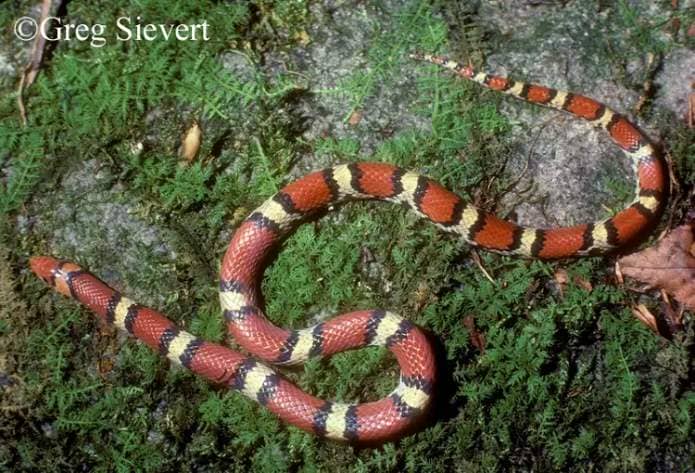 Scarlet snake / Photo courtesy of the Tennessee Wildlife Resources Agency
Scarlet snake / Photo courtesy of the Tennessee Wildlife Resources AgencyDiet: Primarily eggs of other reptiles, especially lizards and snakes. Occasionally eats small mice, lizards or snakes.
Fun facts: The scarlet snake is a mimic of the venomous coral snake, which is not found in Tennessee.
Scarlet snakes have sharp, enlarged teeth in the back of their mouth that are used to pierce shells of large eggs that can’t be swallowed.
— North American racer
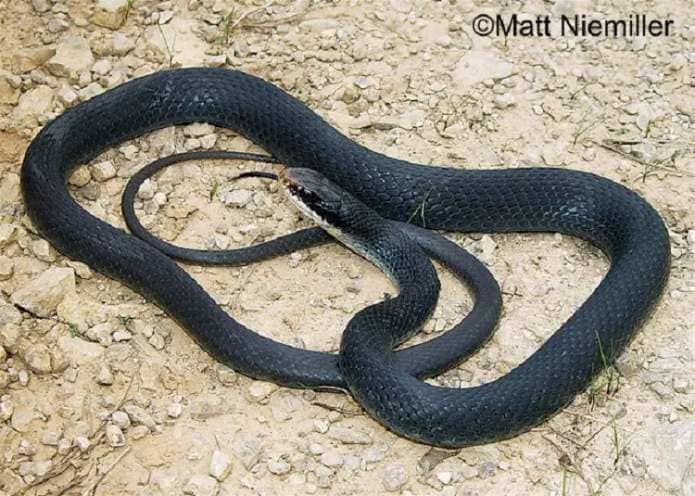 North American Racer / Photo courtesy of the Tennessee Wildlife Resources Agency
North American Racer / Photo courtesy of the Tennessee Wildlife Resources AgencySubspecies: Northern black racer (in the eastern half of Tennessee) and southern black racer (in the western half of the state).
Description: A large, slender, solid black snake (36-60 inches in length) with smooth and shiny scales. The throat and chin have some white, and eye color (iris) is brown or dark amber. The belly is dark gray to dark blue in color. Males are slightly larger than females. Young are lighter in color with dark gray, brown or reddish-brown pattern on the back.
Habitat: Various, but prefers open areas such as old fields, agricultural fields, pastures and forest edges.
 North American Racer / Photo courtesy of the Tennessee Wildlife Resources Agency
North American Racer / Photo courtesy of the Tennessee Wildlife Resources AgencyDiet: A variety, including insects, frogs, birds, other snakes, small rodents and bird eggs.
Fun facts: Racers are named for their incredible speed in escaping from predators.
Black racers use a distinctive hunting strategy known as periscoping, in which they lift the upper part of their body to search for prey.
— Ring-necked snake
 Ring-necked snake / Photo courtesy of the Tennessee Wildlife Resources Agency
Ring-necked snake / Photo courtesy of the Tennessee Wildlife Resources AgencySubspecies: Northern ring-necked snake (in the eastern half of the state) and Mississippi ring-necked snake (in the western half of the state).
Description: A small, slender snake (10-15 inches in length) with smooth scales and a black or dark gray body with a yellow or orange band around the neck. Both subspecies have a bright, yellow belly. The northern ring-necked snake generally has a complete neck ring and unmarked (or few black dots) belly. The Mississippi ring-necked snake has a narrow and often broken-up neck ring and has paired black spots down the center of its belly. Young are similar to adults.
Habitat: Various, but tend to be found in moist woodlands. They spend most of their time underground or hidden under logs, rocks, leaf litter or debris.
Diet: Earthworms, insect larvae, salamanders, small snakes and lizards.
Fun fact: Ring-necked snakes are nicknamed “corkscrew” or “thimble” snakes because of their unique defense behavior of flipping over and tightly coiling their tails to expose their bright bellies.
— Red corn snake (also known as the “red rat snake”)
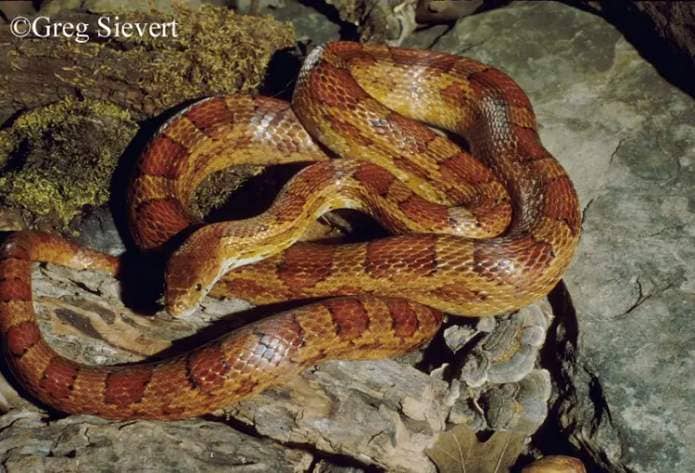 Red corn snake / Photo courtesy of the Tennessee Wildlife Resources Agency
Red corn snake / Photo courtesy of the Tennessee Wildlife Resources AgencyDescription: A long, slender snake (30-48 inches in length) with considerable variation in color and pattern. Red blotches, outlined in black, occur down the middle of the back over a gray to orangish background color. Head has a characteristic spearhead point, which meets between the eyes. Belly is a bold black-and-white checkerboard pattern with striping under the tail. Young are darker and less colorful than adults.
Habitat: Found in a variety of habitats, including wood lots, rocky hillsides, fields, farms and suburban areas but more abundant in areas with pine trees. Found in barns, abandoned buildings, trees and stumps. Also found under leaf litter, soil and other objects. Found mainly in the southern two-thirds of East Tennessee and the southwestern corner of the state.
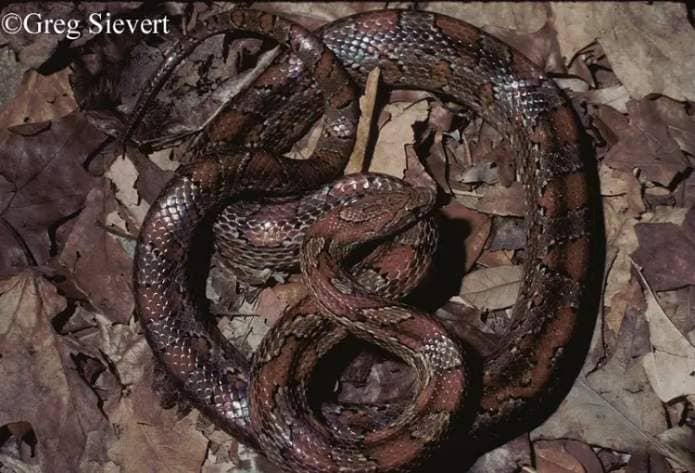 Red corn snake / Photo courtesy of the Tennessee Wildlife Resources Agency
Red corn snake / Photo courtesy of the Tennessee Wildlife Resources AgencyDiet: Feeds heavily on small rodents. Also eats treefrogs, lizards, birds and bats.
Fun facts: Red corn snakes are nocturnal and spend a lot of time crawling through rodent burrows.
They constrict their prey by wrapping one or more coils of their body around it and squeezing.
— Gray rat snake (also known as the “chicken snake”)
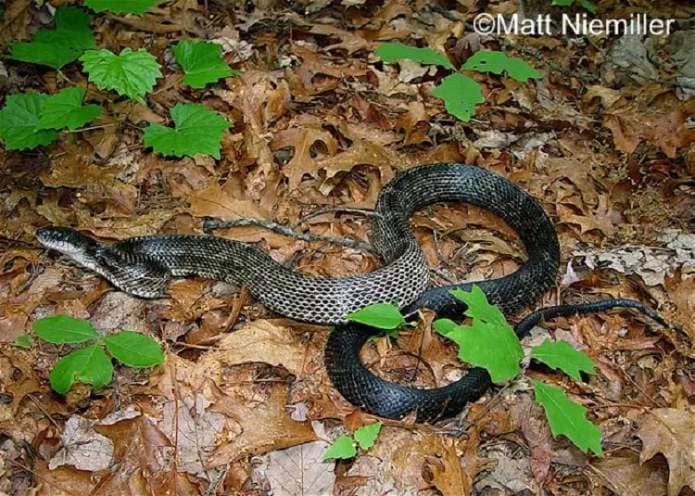 Gray rat snake / Photo courtesy of the Tennessee Wildlife Resources Agency
Gray rat snake / Photo courtesy of the Tennessee Wildlife Resources AgencyDescription: A large snake (42-72 inches in length) with a variable color pattern. Dorsal color is usually black spackled with bits of white between scales and having a light throat. Some may be gray with blotches of brown or darker gray on back. Scales are slightly keeled. Belly is whitish in color near the head but becomes a black checkerboard pattern towards the tail. Juveniles are gray strongly patterned with the brown or dark gray blotches.
Habitat: Various, including woodlands (pine and hardwood), field edges, near streams and around farms and suburban areas. They take shelter in woodpiles, hollow trees, barns and old houses. Found across all of Tennessee.
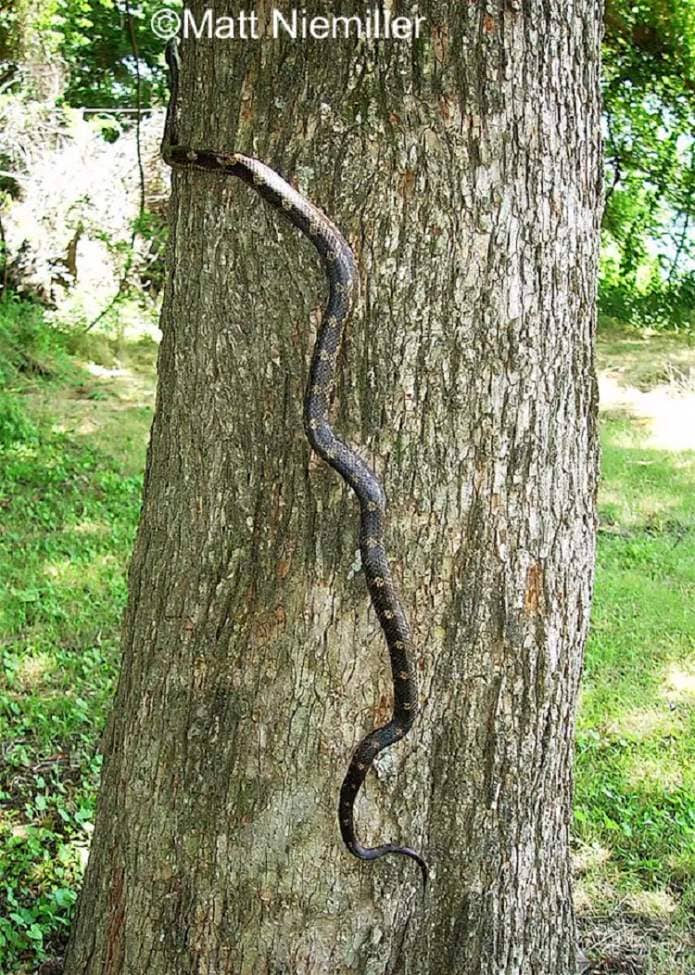 Gray rat snake / Photo courtesy of the Tennessee Wildlife Resources Agency
Gray rat snake / Photo courtesy of the Tennessee Wildlife Resources AgencyDiet: Constricts and eats small mammals and birds. Also swallows bird eggs.
Fun fact: Rat snakes are excellent climbers and are frequently found near or in trees. Sometimes they can be found basking on a horizontal limb.
— Eastern hog-nosed snake (also known as the “puff adder” or “hissing viper”)
 Eastern hog-nosed snake / Photo courtesy of the Tennessee Wildlife Resources Agency
Eastern hog-nosed snake / Photo courtesy of the Tennessee Wildlife Resources AgencyDescription: A stout, medium-sized snake (20-33 inches in length) with variable coloration and pattern. Easily distinguished by its upturned snout. The background color can be yellow, orange, gray, brown or black, with brown, rust or black rectangular patterns down the middle of the back. Some adults may be almost all black or gray with little to no pattern. Belly is gray to yellowish with greenish-gray mottling. Females are longer and heavier than males. Young are more colorfully patterned than adults.
Habitat: Various, but generally prefers areas with sandy or loose soil where they can burrow. They can be found around farms, old fields, river floodplains, open woods or rocky hillsides. Found across the entire state.
Diet: Primarily toads and frogs. Occasionally eats salamanders, lizards and small mammals.
Fun fact: Uses a number of defensive, theatrical tactics when approached, including flattening its head and neck, hissing loudly and striking (without biting), raising its upper body, rolling over to play dead, regurgitating and defecating and releasing musk. If rolled onto its belly while it is playing dead, it will roll onto its back again.
— Yellow-bellied king snake
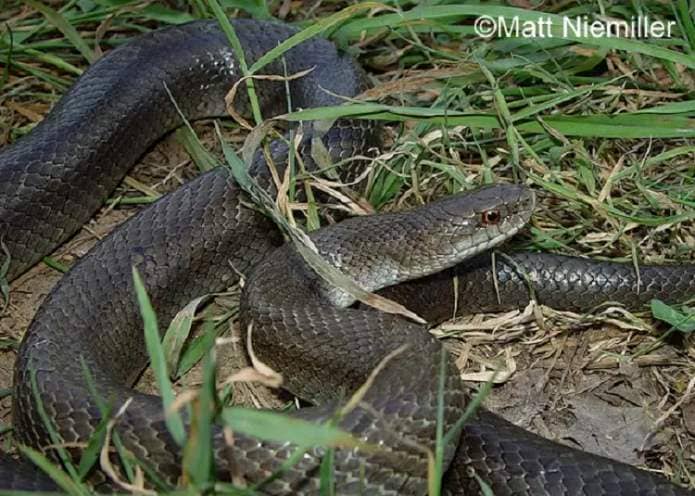 Yellow-bellied king snake / Photo courtesy of the Tennessee Wildlife Resources Agency
Yellow-bellied king snake / Photo courtesy of the Tennessee Wildlife Resources AgencySubspecies: Prairie king snake (in the northern half of Western and Central Tennessee) and mole king snake (in eastern part of the state).
Description: A medium-sized snake (30-42 inches in length) with shiny, smooth scales. Prairie king snakes are tan or gray with brown or reddish, black-edged blotches along the center of the back and two rows of smaller patches along the sides, which are occasionally fused. Mole king snakes are light brown to reddish with rounded, reddish brown blotches bordered by black. A backward pointing arrowhead shape occurs on the top of the head. Belly is yellowish or whitish with alternating square or rectangular brown markings.
Habitat: Typically found in upland forests, woodlots, agricultural fields and suburban areas. Prairie king snakes are generally found in prairie grasslands, agricultural fields or other open areas. Although both subspecies are secretive, the mole king snake is more so by spending much of its life underground in burrows.
Diet: Primarily mice, voles, lizards and small snakes.
Fun facts: The mole king snake is often unearthed from its burrows by farm plows or during excavations.
Like other king snakes, yellow-bellied king snakes are immune from the venom of poisonous snakes and can therefore pursue and eat them.
— Common king snake
 Speckled king snake / Photo courtesy of the Tennessee Wildlife Resources Agency
Speckled king snake / Photo courtesy of the Tennessee Wildlife Resources AgencySubspecies: Eastern king snake (in extreme Southeastern Tennessee), eastern black king snake (in most of Tennessee except northeastern corner) and speckled king snake (in the western and southwestern third of Tennessee)
Description: A large, shiny, black constrictor (36-48 inches in length) with varying yellow or white bands or speckles among the subspecies. The eastern king snake has narrow, light yellowish crossbands that create a chainlike pattern. The eastern black king snake is similar, but its crossbands are small, white or yellowish spots. The speckled king snake has small yellow or white spots over its entire body, creating a “salt-and-pepper” look. The belly is yellow and checkered with black markings.
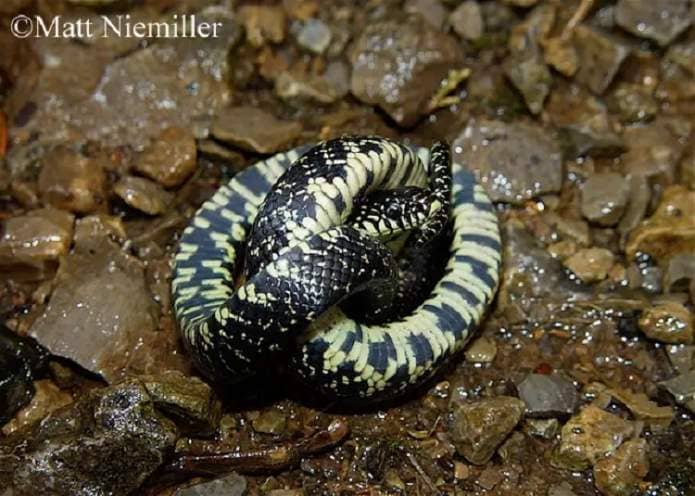 Eastern black king snake / Photo courtesy of the Tennessee Wildlife Resources Agency
Eastern black king snake / Photo courtesy of the Tennessee Wildlife Resources AgencyHabitat: Various, including forests, fields, shrubby areas, forest edges, urban areas and edges of wetlands. Common king snakes have a preference for streambanks and wetlands but are also seen under wood or debris piles, climbing in barns or on stonewalls and sunning in clearings or on hillsides.
Diet: Constricts and eats rodents, rabbits, amphibians, birds, bird eggs, lizards and snakes (including venomous snakes).
Fun fact: King snakes are named for their ability to overcome and consume other snakes, especially venomous ones. They play an important ecological role in controlling these venomous snakes, which can pose a threat to humans.
— Milk snake
 Red milk snake / Photo courtesy of the Tennessee Wildlife Resources Agency
Red milk snake / Photo courtesy of the Tennessee Wildlife Resources AgencySubspecies: Eastern milk snake (in upper East Tennessee), red milk snake (across most of West Tennessee) and scarlet king snake (in area from southern Land Between the Lakes southward along the Tennessee River to the Mississippi/Alabama border)
Description: A slender, medium-sized, shiny snake (24-36 inches in length for eastern; 21-28 for red; 14-20 for scarlet king snake) with bright colors or strong patterns. The eastern milk snake has a gray or tan body with irregular brownish or reddish-brown, black-bordered blotches down the back. Sometimes has a pale “Y” or “V” shaped mark on the back of the head. Smaller, similar blotches also extend along the lower sides.
The red milk snake has a white or yellow body with red, reddish-brown or orange-red, black-bordered blotches on the back. Small, black markings occur along the sides.
The scarlet king snake has a red snout and alternating bands of red, black and yellow the length of the body in which red touches black but not yellow. The belly is marked with a black and white checkerboard pattern, except the dorsal pattern on the scarlet king snake continues onto the belly.
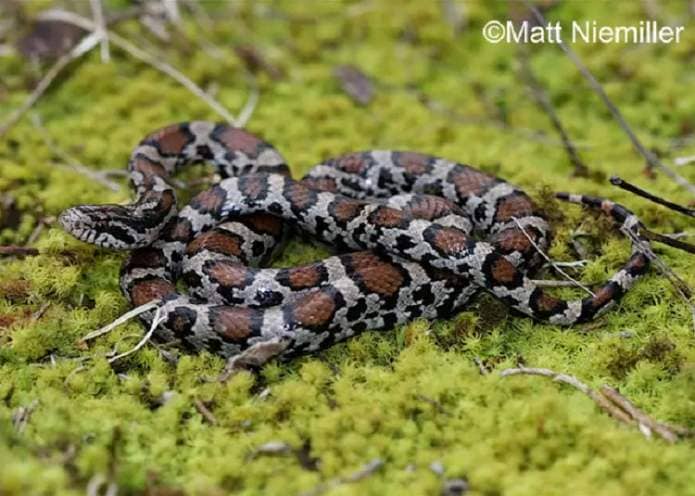 Eastern milk snake / Photo courtesy of the Tennessee Wildlife Resources Agency
Eastern milk snake / Photo courtesy of the Tennessee Wildlife Resources AgencyHabitat: Various, but generally prefer pine or hardwood forests with rock outcroppings. They also live under rocks or logs in other habitats, including fields, savannahs, agricultural, suburban, wetlands and forest edges. All three subspecies can be found in middle and lower East Tennessee.
Diet: Prefers mice, shrews and voles, but also eats lizards, snakes, birds and eggs.
Fun facts: Its name comes from an old wives’ tale that incorrectly thought these snakes could milk cows.
Scarlet king snakes are the most strikingly colored snake in the Tennessee region.
— Rough green snake (also known as the “vine snake”)
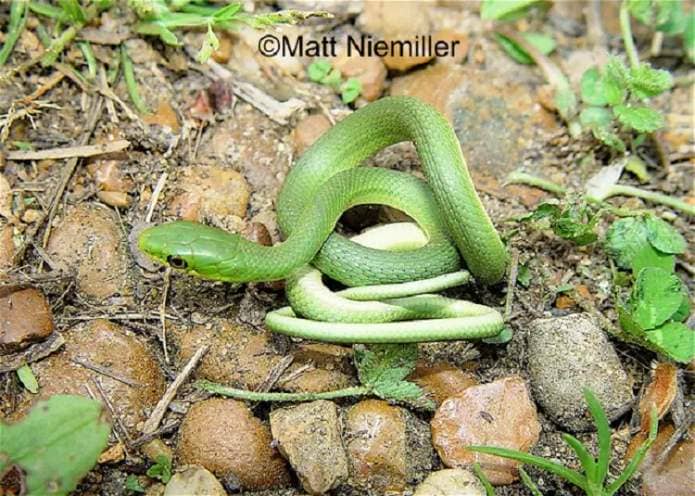 Rough green snake / Photo courtesy of the Tennessee Wildlife Resources Agency
Rough green snake / Photo courtesy of the Tennessee Wildlife Resources AgencySubspecies: Northern rough green snake
Description: A slender, moderately long snake (22-32 inches in length), which is light green and has keeled scales. Belly is white, yellow or pale greenish. Males have longer tails than females. Young are a grayish-green color.
Habitat: Found in dense vegetation, especially along the edges of streams, rivers, ponds and lakes. Often found on overhanging limbs. They can also be found along river bluffs, on forested hillsides and in shrub and forest-edge habitats. Found across Tennessee except for the upper northeastern area.
 Rough green snake / Photo courtesy of the Tennessee Wildlife Resources Agency
Rough green snake / Photo courtesy of the Tennessee Wildlife Resources AgencyDiet: Mainly spiders, grasshoppers, crickets, caterpillars and dragonflies.
Fun facts: Rough green snakes turn blue when they are dead.
A very arboreal, camouflaged snake that is an excellent climber and becomes almost invisible in dense, green shrubs and vines.
— Pine snake
 Pine snake / Photo courtesy of the Tennessee Wildlife Resources Agency
Pine snake / Photo courtesy of the Tennessee Wildlife Resources AgencySubspecies: Northern pine snake.
Description: A large, heavy-bodied constrictor (48-66 inches in length) with four prefrontal scales (scales between and just in front of eyes) and keeled scales. Body color is white, yellowish or light gray with dark brown to reddish blotches on the sides and back that are lighter toward the tail and darker (almost black) near the head.
The blotches toward the tail resemble a saddle pattern and may form complete rings on the tail itself. The belly is whitish to yellow with little to moderate black spotting. Young have a paler ground color with a pink or orange tinge.
Habitat: Primarily found in well-drained, sandy soils, especially in pine or mixed pine-hardwood forests. They can also be found in scrub, agricultural and dry mountain ridge habitats. Found across the state except in most of West Tennessee, the Central Basin of Middle Tennessee and the northern parts of East Tennessee.
Diet: Mainly small rodents but may also eat ground-nesting birds and their eggs.
Fun facts: Pine snakes have the largest eggs of any North American snake.
Pine snakes exhibit a remarkable defensive display. When threatened, they hiss loudly, vibrates their tails against leaf litter, inflate their bodies, raise the front of their bodies and strike with their mouths closed or partially open.
— Queen snake (also known as the “willow snake” or “leather snake”)
 Queen snake / Photo courtesy of the Tennessee Wildlife Resources Agency
Queen snake / Photo courtesy of the Tennessee Wildlife Resources AgencyDescription: A slender, medium-sized, aquatic snake (15-24 inches in length) with a creamy white to pale yellow stripe running along the lower sides of its light brown to grayish body. Three faint black stripes may be visible along the sides. Scales are keeled. Belly is yellow with four brown stripes (two down the center are more narrow). Young resemble adults but have three additional stripes on back.
Habitat: Prefers cool, rocky streams and rivers. Often found under large rocks or logs around the edges of streams or rivers, occasionally basking on branches over water. Found in Middle and East Tennessee.
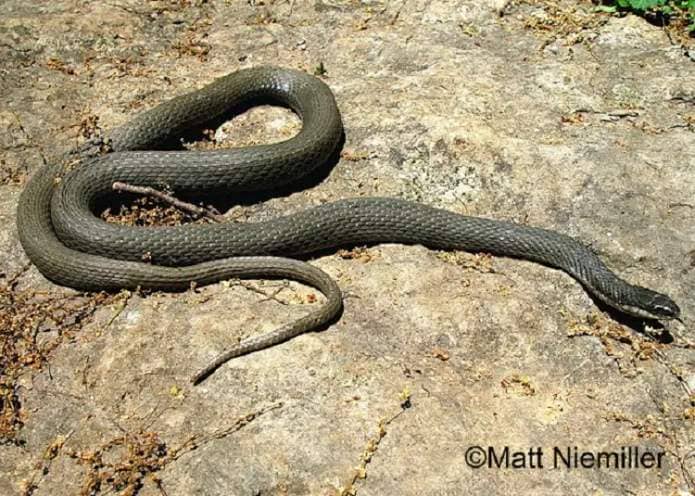 Queen snake / Photo courtesy of the Tennessee Wildlife Resources Agency
Queen snake / Photo courtesy of the Tennessee Wildlife Resources AgencyDiet: Feeds almost exclusively on soft, newly molted crayfish. Also eats fish and tadpoles.
Fun fact: It’s the only North American water snake with four brown stripes on its belly.
— DeKay’s brown snake
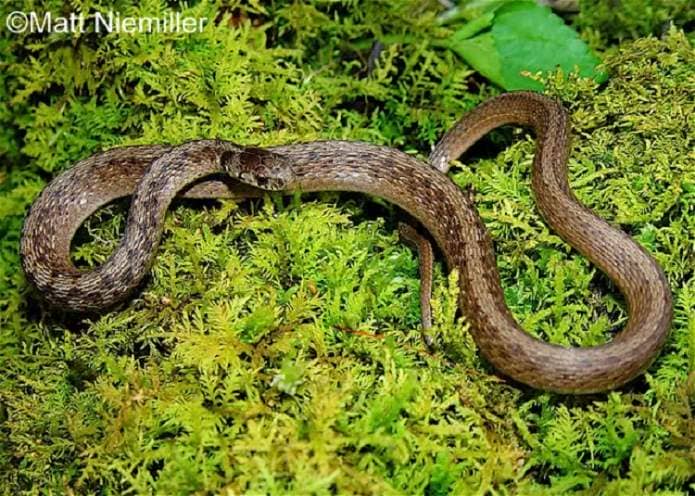 DeKays brown snake / Photo courtesy of the Tennessee Wildlife Resources Agency
DeKays brown snake / Photo courtesy of the Tennessee Wildlife Resources AgencySubspecies: Midland brown snake (across most of the state) and northern brown snake (in the southeastern quarter of the state).
Description: A small, keel-scaled snake (9-13 inches in length) with variable coloration. Dorsal color can be gray, brown or reddish-brown with two parallel rows of dark spots down the back (spots are connected by a narrow brown crossline in the midland brown snake). The top of the head is dark, and a dark, downward streak occurs on each side of the head. The belly is yellowish, tan or pinkish with small black dots on the sides. Young are much darker with faint spots and have a conspicuous yellowish collar across neck.
 DeKays brown snake / Photo courtesy of the Tennessee Wildlife Resources Agency
DeKays brown snake / Photo courtesy of the Tennessee Wildlife Resources AgencyHabitat: Various, but prefers moist environments in pine or hardwood forests, river floodplains, urban areas or edges of wetlands. Often found in gardens, rock piles, wood piles, cemeteries, parks and empty lots.
Diet: Earthworms, snails, spiders, soft-bodied insects, small amphibians and fish.
Fun fact: Named after James Edward DeKay, who was an 19th century naturalist and writer in New York.
— Red-bellied snake
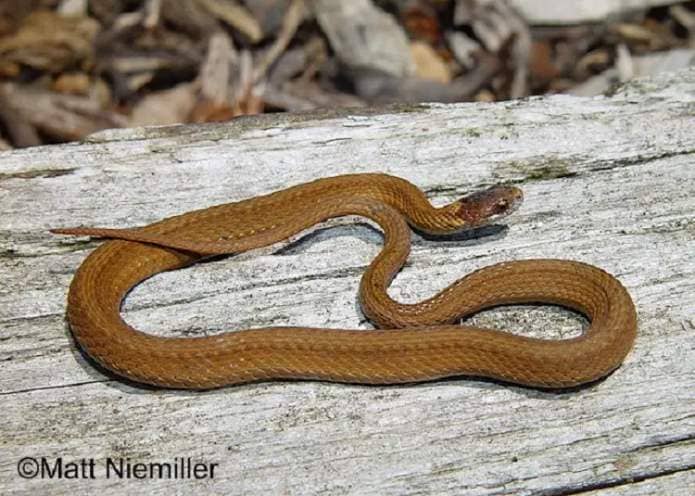 Red-bellied snake / Photo courtesy of the Tennessee Wildlife Resources Agency
Red-bellied snake / Photo courtesy of the Tennessee Wildlife Resources AgencySubspecies: Northern red-bellied snake (found across most of the state) and Florida red-bellied snake (in the southwestern counties of the state).
Description: A small, keel-scaled snake (8-10 inches in length) with a plain reddish belly.
The northern red-bellied subspecies has three light spots on the nape of the neck, and these spots are fused to make a distinct pale neck collar in the Florida red-bellied subspecies.
The body color is highly variable but is usually gray or reddish-brown (rarely black) with or without four narrow, dark stripes or a broad, light mid-dorsal stripe. The belly is usually red but can be yellow, orange or pink. The head is usually darker than the body. Young are darker overall with a more distinctive neck collar.
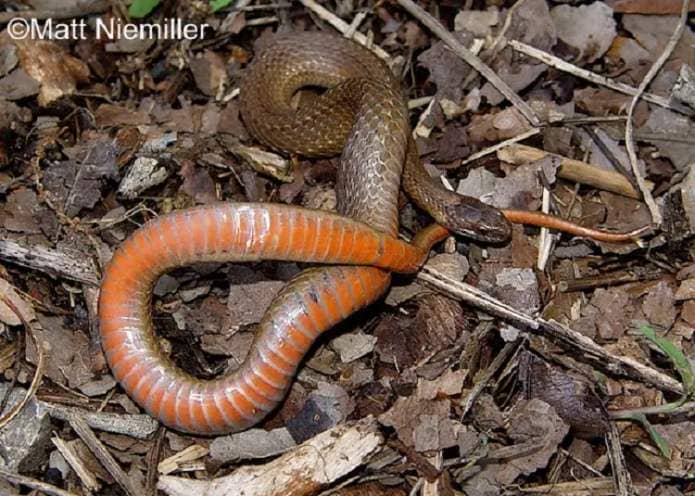 Red-bellied snake / Photo courtesy of the Tennessee Wildlife Resources Agency
Red-bellied snake / Photo courtesy of the Tennessee Wildlife Resources AgencyHabitat: Found under leaf litter, rotten logs, bark and rocks in moist hardwood or mixed pine-hardwood forests and other moist sites such as bottomland habitat. Red-bellied snakes can also be found in vacant lots, where they hide under boards, trash and other debris.
Diet: Primarily slugs, snails, earthworms and other soft-bodied insects.
Fun fact: Red-bellied snakes have a habit of lip curling, which is thought to be related to their habit of eating slimy prey such as slugs, earthworms and snails.
— Common garter snake
 Common garter snake / Photo courtesy of the Tennessee Wildlife Resources Agency
Common garter snake / Photo courtesy of the Tennessee Wildlife Resources AgencySubspecies: Eastern garter snake (found all across the state).
Description: A medium-size, keel-scaled snake (18-26 inches in length) that is highly variable in coloration and pattern. Typically has three light stripes, which can be white, yellow, blue, brown or green running along the length of the black, brown or olive body. One stripe runs down the center of the snake’s back, while the other two run down each side on scale rows two and three (counting up from the belly scales).
Some specimens have faint stripes or lack them altogether. The area between the stripes on each side usually has a double row of alternating dark spots. Their tongues are red with a black tip. Belly is greenish or yellowish with two rows of faint black spots that are partially hidden by overlapping belly scales. Males are smaller than females and have longer tails. Young are similar in appearance to adults.
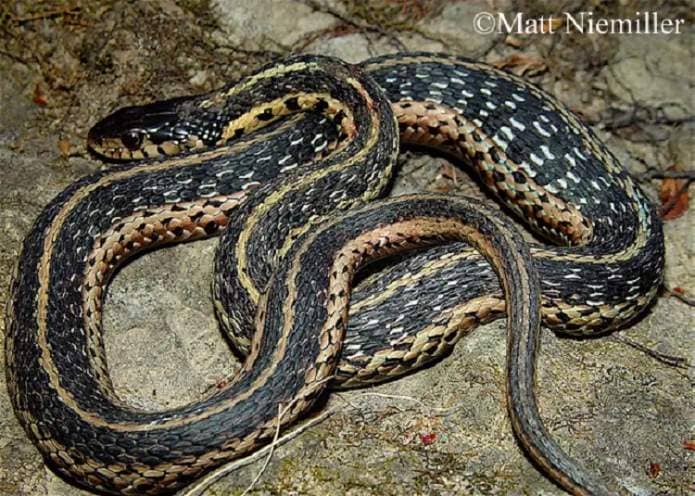 Common garter snake / Photo courtesy of the Tennessee Wildlife Resources Agency
Common garter snake / Photo courtesy of the Tennessee Wildlife Resources AgencyHabitat: Various, mostly found near water such as ponds, wetlands, drainage ditches, edges of streams or damp woods. Also found in fields, vacant city lots, parks, cemeteries and old farms.
Diet: Varies, but mainly frogs, toads, tadpoles, salamanders, fish and earthworms.
Fun fact: Common garter snakes are named for the long stripes along their sides, which resemble the stripes from old-fashioned men’s garters used to hold up their socks.
— Smooth earth snake (also known as the “ground snake” or “little brown snake”)
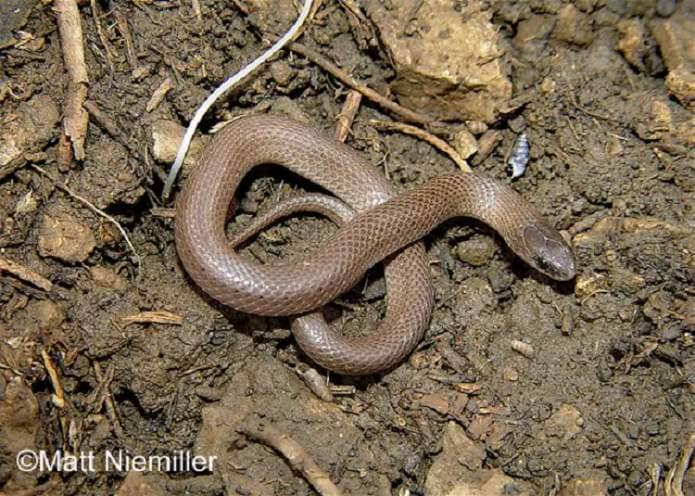 Smooth earth snake / Photo courtesy of the Tennessee Wildlife Resources Agency
Smooth earth snake / Photo courtesy of the Tennessee Wildlife Resources AgencySubspecies: Western smooth earth snake (in West Tennessee and northwest Middle Tennessee) and eastern smooth earth snake (in East Tennessee except the northeast corner).
Description: A small, plain-looking snake (7-10 inches in length) with a narrow head, six labial scales (upper lip) and loreal scales (in front of eyes) that are horizontal and touching the eye. The eastern smooth subspecies is mostly gray or light brownish-gray with tiny black dots scattered on the back and smooth scales (except on back near tail).
The western smooth subspecies is reddish to grayish-brown with weakly keeled scales. Both subspecies have a white or cream-colored belly, but the western smooth earth snake has a pale greenish-yellow tint. Young are similar to adults and do not have markings.
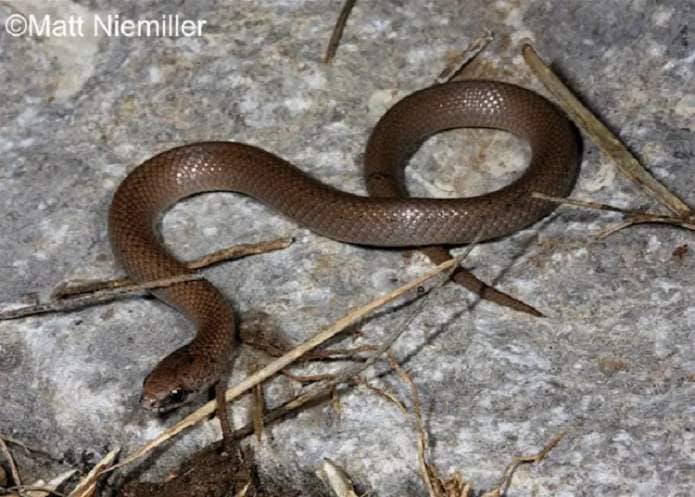 Smooth earth snake / Photo courtesy of the Tennessee Wildlife Resources Agency
Smooth earth snake / Photo courtesy of the Tennessee Wildlife Resources AgencyHabitat: Various, including rocky hillsides, pine and hardwood forests, forest edges, fields and some suburban areas. These snakes are burrowers that spend most of their time under rocks, leaf litter, logs or trash. Found across most of Tennessee.
Diet: Primarily earthworms, but also eats slugs, snails and soft-bodied insects and their larvae.
OTHER NON-VENOMOUS SNAKES IN TENNESSEE
— Red-bellied mud snake
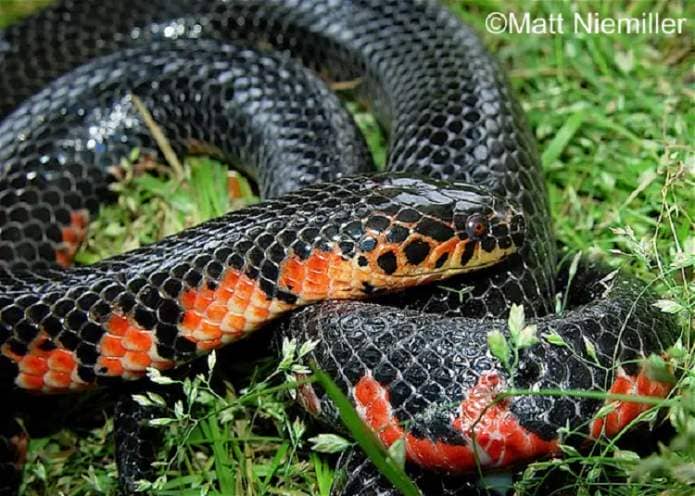 Red-bellied mud snake / Photo courtesy of the Tennessee Wildlife Resources Agency
Red-bellied mud snake / Photo courtesy of the Tennessee Wildlife Resources AgencySubspecies: Western mud snake (in western coastal plain of Tennessee).
Description: A large, heavy-bodied snake (40-54 inches in length). Smooth, glossy black snake with a red and black checkered belly; red extends up onto sides creating red triangle pattern. Chin is heavily marked with black and may be yellowish creating a “zipper-like” appearance. Males are smaller and have shorter tails than females. Young have sharp tail tips in contrast to blunt tips for adults.
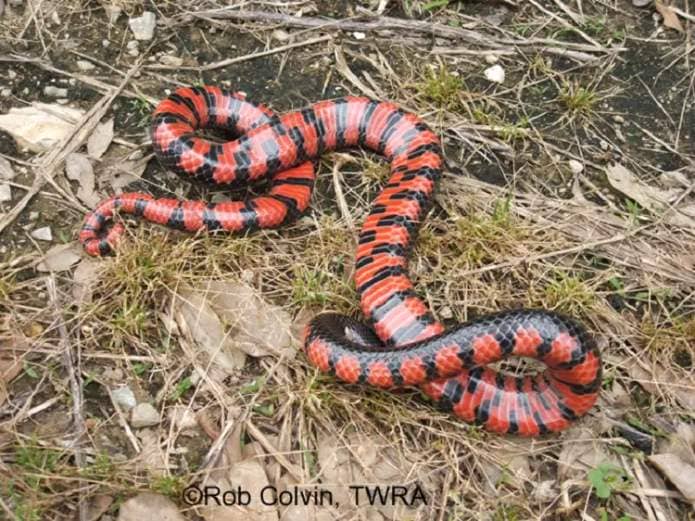 Red-bellied mud snake / Photo courtesy of the Tennessee Wildlife Resources Agency
Red-bellied mud snake / Photo courtesy of the Tennessee Wildlife Resources AgencyHabitat: Typically found in stagnant, muddy waters of shallow streams, rivers and swamps. Often found under rotten or water-soaked logs or other debris.
Diet: Has a specialized diet preference of three-toed amphiuma and lesser siren.
Fun facts: Mud snakes are known as “horn snakes” or “stinging snakes” because of their tendency to press their hard-tipped tails against the skin of their captors.
They may play dead or go limp if handled too much.
— Coachwhip
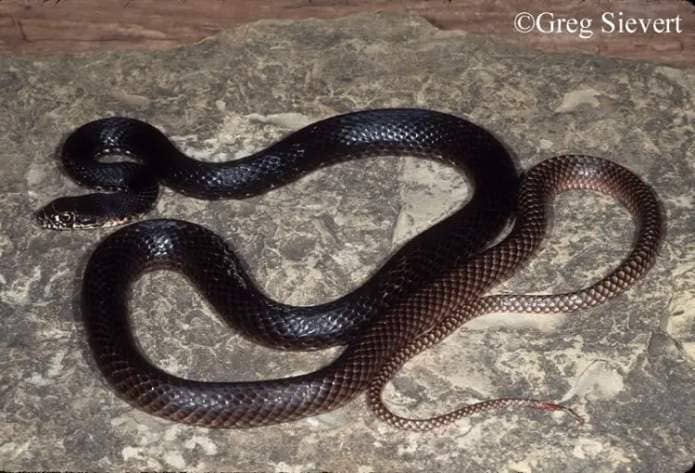 Coachwhip snake / Photo courtesy of the Tennessee Wildlife Resources Agency
Coachwhip snake / Photo courtesy of the Tennessee Wildlife Resources AgencySubspecies: Eastern coachwhip (in southwestern corner of the state).
Description: A long, slender, smooth-scaled snake (42-60 inches in length) with a unique darker half towards the head and lighter back half. Anterior color ranges from dark brown to black, while the posterior color is caramel to tan, frequently with reddish tint along sides of tail. Belly coloration may be tan, light yellow or pink. Scales, especially towards the tail, resemble a braided rope. Young have dark crossbands over a tan body with white markings on head and neck.
Habitat: Found primarily in dry, open habitats with sandy soils. Eastern coachwhips can also be found in scrub, wooded hillsides, pine woods, old fields and farmland areas.
Diet: Lizards, snakes, small mammals and birds. Occasionally eats insects and small turtles.
Fun facts: Coachwhips get their name from the likeness of their long, thin bodies and the braided look of their scales to the whips used by stagecoach drivers.
Like racers, coachwhips use periscoping (lifting the upper part of their body to search for prey) to actively hunt by sight.
— Mississippi green water snake
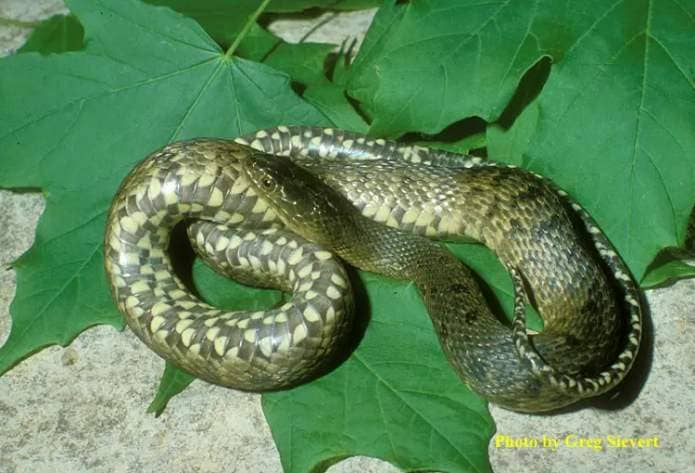 Mississippi green water snake / Photo courtesy of the Tennessee Wildlife Resources Agency
Mississippi green water snake / Photo courtesy of the Tennessee Wildlife Resources AgencyDescription: A medium-sized, semi-aquatic snake (30-45 inches in length) with a dark greenish-brown color and small, obscure dark markings. Has distinctive row of scales between eye and lip plates. Belly is dark gray covered with pale yellow half-moons. Young have more distinct dorsal markings.
Habitat: Prefers the quiet waters of swamps, wetlands, river sloughs and lake edges. Frequently found around cypress or tupelo swamps. Resides in the cypress swamps of extreme Western Tennessee. May be seen basking in branches overhanging water.
Diet: Primarily eats fish, frogs, tadpoles, crayfish and salamanders.
Fun fact: They are ovoviviparous, meaning the females retain their eggs in the oviduct during the development of the young. Thus, the young are born “live” and completely developed.
— Plain-bellied water snake
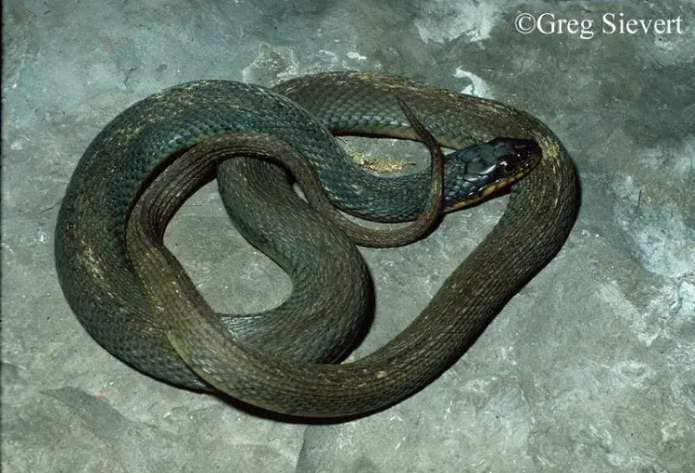 Yellow-bellied water snake / Photo courtesy of the Tennessee Wildlife Resources Agency
Yellow-bellied water snake / Photo courtesy of the Tennessee Wildlife Resources AgencySubspecies: Yellow-bellied water snake (in South-Central and Southwestern Tennessee) and copper-bellied water snake (in the lower Cumberland River and Tennessee River watersheds of Middle Tennessee)
Description: A medium-sized, semi-aquatic snake (30-48 inches in length) with a heavy body and keeled scales (not shiny). Adults are uniformly reddish-brown to almost black with a grayish or greenish cast on the lower sides.
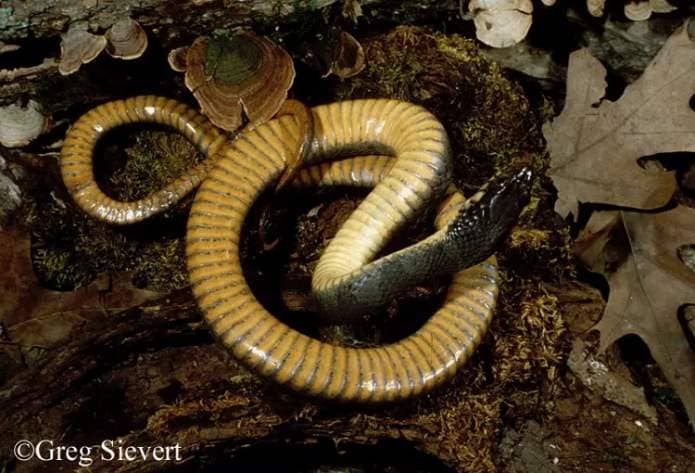 Yellow-bellied water snake / Photo courtesy of the Tennessee Wildlife Resources Agency
Yellow-bellied water snake / Photo courtesy of the Tennessee Wildlife Resources AgencyAs the names suggest, bellies are plain yellow (sometimes with orange) in the yellow-bellied water snake and red to orange-red (with brown dorsum color creeping onto belly) in the copper-bellied water snake.
Young are boldly patterned with complete dark crossbands just behind head transitioning into alternating back and side blotches.
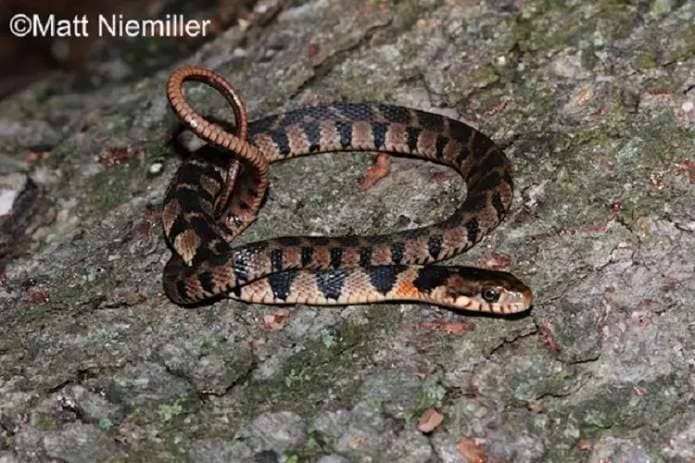 Juvenile plain-bellied water snake / Photo courtesy of the Tennessee Wildlife Resources Agency
Juvenile plain-bellied water snake / Photo courtesy of the Tennessee Wildlife Resources AgencyHabitat: Found in quiet pools of water such as lakes, cypress swamps, wetlands, ponds, river sloughs and slow-moving rivers.
Diet: Prefers frogs, toads, tadpoles and salamanders. Also eats fish and crayfish.
Fun fact: It’s unique among watersnakes in that it flees onto land instead of diving underwater when approached.
— Southern water snake (also known as the “yellow moccasin” or “pink flamingo snake”)
 Southern water snake / Photo courtesy of the Tennessee Wildlife Resources Agency
Southern water snake / Photo courtesy of the Tennessee Wildlife Resources AgencySubspecies: Broad-banded water snake (in Reelfoot Lake and counties that border the Mississippi River).
Description: A medium-sized, semi-aquatic snake (22-36 inches in length) with broad brown, red-brown or black crossbands separated by yellow to grayish bands. Variations in band color occur across its range. Belly is yellow patterned with bold, square, black markings. A faint black line runs from the corner of the eye diagonally to the corner of the mouth. Young are more brightly colored.
Habitat: Prefers cypress swamps, marshes, river sloughs and shallow lakes. Frequently found among thick vegetation, basking on logs or on branches overhanging water.
Diet: Primarily fish, frogs, toads and tadpoles. Occasionally eats salamanders and crayfish.
— Diamond-backed water snake
 Diamond-backed water snake / Photo courtesy of the Tennessee Wildlife Resources Agency
Diamond-backed water snake / Photo courtesy of the Tennessee Wildlife Resources AgencySubspecies: Northern diamond-backed water snake (in the Mississippi and Tennessee River drainages in West Tennessee, also the Cumberland River drainage in Stewart and Montgomery counties in Middle Tennessee)
Description: A large, keel-scaled, heavy-bodied snake (30-48 inches in length) with light patterns on the back that somewhat resemble diamond shapes. These diamonds are created by dark brown chainlike markings extending over the body on a light brown or yellowish ground color. The belly is yellow with irregular rows of black “half-moons.” Males have small raised bumps (papillae) under the chin. Young are strongly patterned and have bright orange on their bellies.
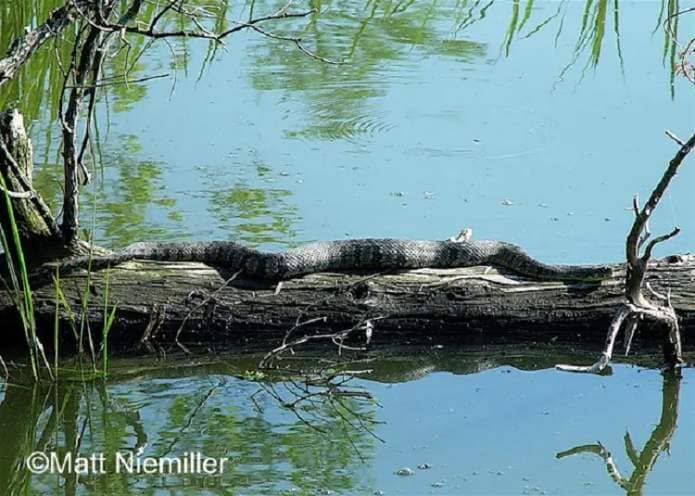 Diamond-backed water snake / Photo courtesy of the Tennessee Wildlife Resources Agency
Diamond-backed water snake / Photo courtesy of the Tennessee Wildlife Resources AgencyHabitat: Various aquatic habitats, but usually in oxbow lakes, rivers, cypress swamps, marshes and sloughs.
Diet: Slow-moving fish, frogs, toads and salamanders.
Fun fact: Diamond-backed water snakes become more nocturnal as the weather becomes warmer.
— Northern water snake
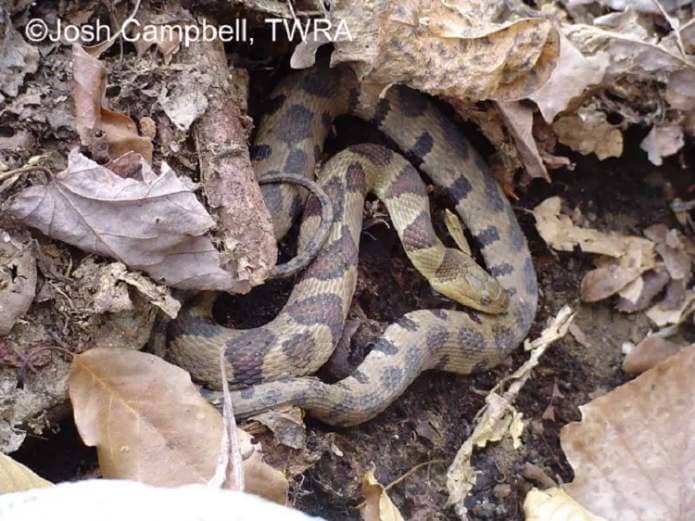 Northern water snake / Photo courtesy of the Tennessee Wildlife Resources Agency
Northern water snake / Photo courtesy of the Tennessee Wildlife Resources AgencySubspecies: Midland water snake (in the western two-thirds of Tennessee) and common water snake (in Northeastern Tennessee).
Description: A large, heavy-bodied water snake (24-42 inches in length) that has keeled scales and is variable in color. Body may be grayish to brown (almost black in older specimens) with dark brown to reddish-brown crossbands on the front third of the body becoming broken into three rows of alternating blotches.
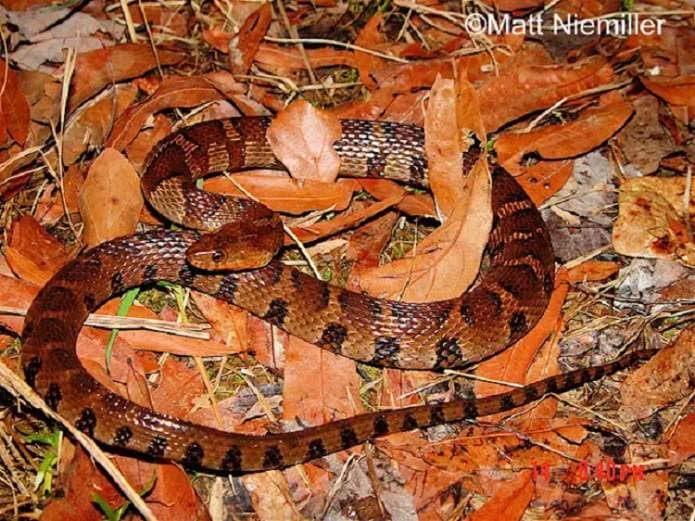 Midland water snake / Photo courtesy of the Tennessee Wildlife Resources Agency
Midland water snake / Photo courtesy of the Tennessee Wildlife Resources AgencyThe midland water snake has less than 30 crossbands and blotches, and the light spaces between the dark lateral markings are more than 2 1/2 scale rows wide. The common water snake has more than 30 crossbands and light spaces are less than 2 1/2 scale rows wide.
The midland subspecies has a yellow belly distinctly marked with two rows of half moons, while the half moon markings on the common subspecies are broken up or not clear. Young are similar but more boldly patterned.
 Northern water snake / Photo courtesy of the Tennessee Wildlife Resources Agency
Northern water snake / Photo courtesy of the Tennessee Wildlife Resources AgencyHabitat: Found in every type of water body but prefers quiet waters. Northern water snakes are found in ponds, lakes, rivers, streams, sloughs, wetlands and temporary water pools. Frequently found around edges of ponds or lakes, basking on rocks or on vegetation overhanging water. This is the most common water snake in Tennessee and is found statewide.
Diet: Primarily nongame fish. Also eats amphibians and other small aquatic animals.
Fun fact: When threatened, northern water snakes will make a silent retreat but are aggressive when captured. They will flatten their head and neck, try to strike and bite, and discharge a foul-smelling musk from glands at the base of their tail.
— Southeastern crowned snake
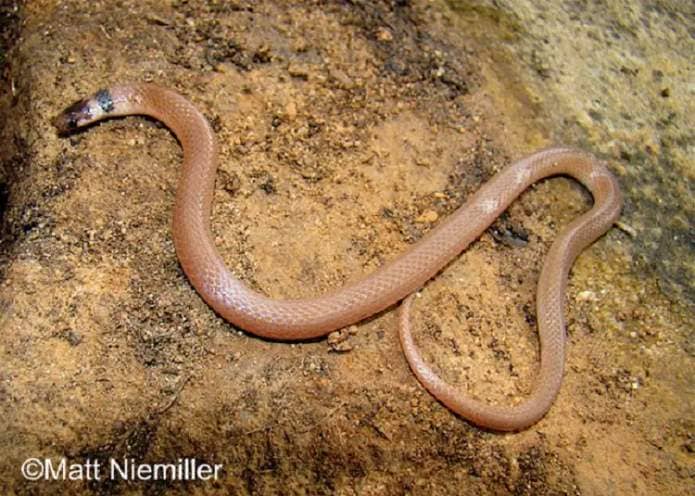 Southeastern crowned snake / Photo courtesy of the Tennessee Wildlife Resources Agency
Southeastern crowned snake / Photo courtesy of the Tennessee Wildlife Resources AgencyDescription: A slender, very small snake (8-10 inches in length) with smooth scales and a black head. A light-colored band occurs on the neck separating the black head and black neck band. The body is light brown to reddish brown. Belly is white, light pink, or yellowish. Young resemble adults.
Habitat: Frequently found in sandy-soiled areas, pine forests, hardwoods and swamps. They are mainly burrowers and live beneath rocks, woody debris, leaf litter and other debris. Found across the southern two-thirds of the state plus Stewart County.
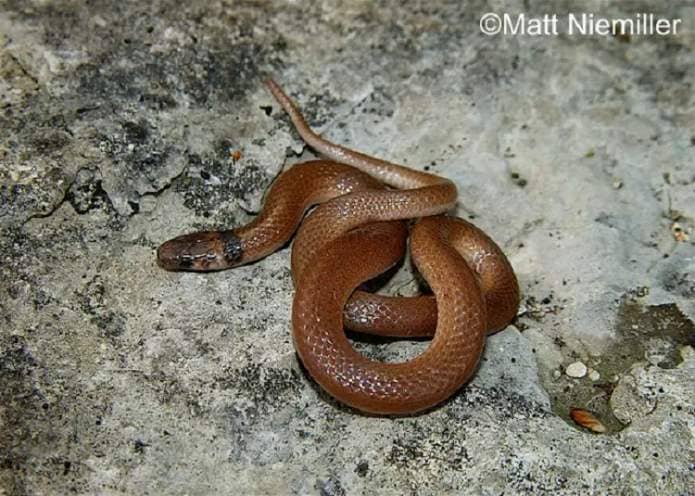 Southeastern crowned snake / Photo courtesy of the Tennessee Wildlife Resources Agency
Southeastern crowned snake / Photo courtesy of the Tennessee Wildlife Resources AgencyDiet: Prefers centipedes and insect larvae. Also eats earthworms, spiders, termites and snails.
Fun fact: Southeastern crowned snakes have small rear fangs in the upper jaw, which they use to inject venom into insect prey. These fangs do not pose a threat to humans, especially since these snakes do not bite when captured.
— Western ribbon snake
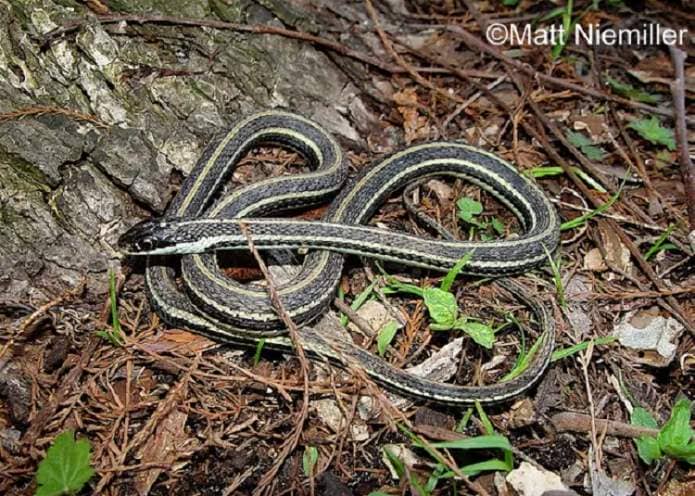 Western ribbon snake / Photo courtesy of the Tennessee Wildlife Resources Agency
Western ribbon snake / Photo courtesy of the Tennessee Wildlife Resources AgencySubspecies: Orange-striped ribbon snake (found in only four counties in the far western part of Tennessee).
Description: A slim, medium-sized snake (20-30 inches in length) with long tail (approximately 1/3 of the total length) and keeled scales. Three light, longitudinal stripes run the length of the black body. The mid-dorsal stripe is usually orange, while the side stripes are narrow and yellow and on the third and fourth scale rows (counting up from the belly scales). Head is black with large, yellow or orange spots that touch each other. Lower jaw lacks black markings. The unmarked belly is cream-colored or light green. Young are identical to adults.
Habitat: These semi-aquatic snakes prefer areas near water such as streams, rivers, wetlands, sloughs and ponds.
Diet: Mainly small frogs, tadpoles, toads, salamanders and minnows.
— Eastern ribbon snake
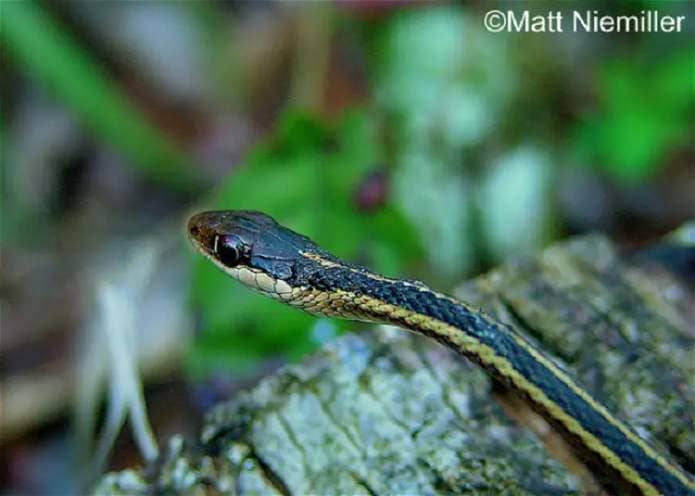 Eastern ribbon snake / Photo courtesy of the Tennessee Wildlife Resources Agency
Eastern ribbon snake / Photo courtesy of the Tennessee Wildlife Resources AgencySubspecies: Common ribbon snake (in West Tennessee and in several counties on the Highland Rim in southern and western Middle Tennessee).
Description: A slender, medium-sized snake (18-26 inches in length) with long tail (approximately 1/3 of the total length) and keeled scales. Three light stripes, usually yellow, extend the length of the dark body. One stripe runs down the center of the back, which may have orangish or greenish tinge, and one runs down each side on the third and fourth scale rows (counting up from the belly scales). The dark head may have faint, light spots that do not touch each other. Lower jaw lacks black markings. The unmarked belly is white to yellowish or light green. Young are identical to adults.
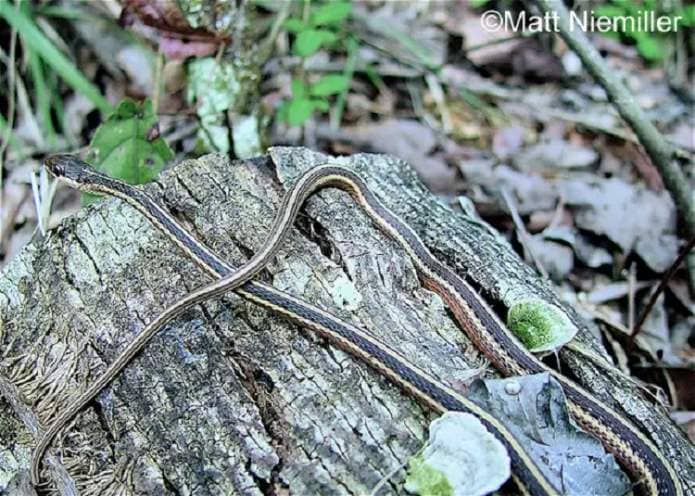 Eastern ribbon snake / Photo courtesy of the Tennessee Wildlife Resources Agency
Eastern ribbon snake / Photo courtesy of the Tennessee Wildlife Resources AgencyHabitat: This semi-aquatic snake rarely travels far from water. Often found along the grassy or brushy edges of streams, rivers, ponds, lakes, sloughs or wetlands.
Diet: Prefers frogs, toads, salamanders and fish. Occasionally eats spiders and insects.
Fun facts: Ribbon snakes are one of the fastest snakes in Tennessee, making them very difficult to catch.
When escaping into water, these snakes glide smoothly across the surface instead of diving.
— Rough earth snake
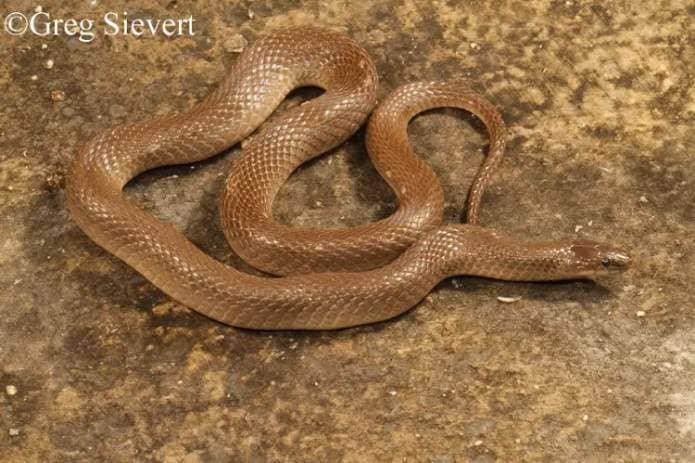 Rough earth snake / Photo courtesy of the Tennessee Wildlife Resources Agency
Rough earth snake / Photo courtesy of the Tennessee Wildlife Resources AgencyDescription: A small, keel-scaled snake (7-10 inches in length) that is gray, brown or reddish- brown and has a pointed snout. Identity can be confirmed by five labial scales (upper lip) and loreal scales (in front of eyes) that are horizontal and touching the eye. Belly is cream-colored or light gray. Males have a longer tail than females. Young are darker and grayer, and have a light band across the back of their head.
Habitat: Various, including rocky hillsides, pine and hardwood forests, forest edges and suburban and urban areas. These are burrowers that spend most of their time under rocks, leaf litter, logs or trash. Found only in a few counties in the southwestern corner of the state, mostly around Memphis.
 Rough earth snake / Photo courtesy of the Tennessee Wildlife Resources Agency
Rough earth snake / Photo courtesy of the Tennessee Wildlife Resources AgencyDiet: Primarily earthworms but also eats slugs, snails and soft-bodied insects and their larvae.
Fun fact: These secretive snakes rarely venture above ground but occasionally will surface after a cool, heavy rain.
Sources: Centers for Disease Control and Prevention, Tennessee Wildlife Resources Agency


